2025-12-19 03:38:00
The SWD team making chocolate in London after a public masterclass, April 2025. A fermata over a quarter-rest.
(L–R: Simon, Amy, Jody, Kaitlin, Mike, Alex, Cole, Randy) 
In music, a fermata signals an extension—a moment to hold a note, or a rest, longer than expected. It doesn’t mean the piece is over, but rather that we sit in anticipation, or we take a breath...letting something resonate a little longer before moving on.
This time of year feels like that: a natural but longer-than-normal pause in the rhythm of work and life. At SWD, we formally put work on hold (for two weeks, from close of business on Friday the 19th until Monday, January 5th), and use this time to reflect on what’s happened, what’s changed, and what lies ahead.
This year brought the publication of storytelling with data: before & after. Working on the book gave us a reason to look back through years of client work, and remember those folks who had invited us into their world, trusted us with their data, and asked thoughtful questions about how to make it better. As we selected which examples to include and revisited the visual makeovers themselves, we found ourselves remembering the unique challenges they were trying to solve, as well as the conversations and energy in the room when we revealed an "after" version. From Toronto to Trinidad, from the Bay Area to Boston to Belgium, and dozens of places in between, each session brought something different. And revisiting those moments reminded us just how lucky we’ve been to work with so many smart, curious, and generous people, all striving to make their data clearer and their stories stronger.
We also marked a milestone this year with the release of the 10th anniversary edition of storytelling with data. Revisiting the original book a decade after it first came out reminded us how much has changed (tools, terminology, ways of working), but how much more has held steady. The need for clear, thoughtful communication with data is just as relevant now as it was then, and in many ways, even more critical. What has evolved is how we teach and apply those ideas, shaped by years of continued learning and the experiences we've had working with so many of you.
And of course, this time of year inevitably inspires us to reflect on the changes we’ve seen over the past year. Change, after all, is both inevitable and unrelenting. It can be exciting, or difficult, or both. Maybe most often, it’s both. This year, like every year, brought transitions to SWD, both big and small. What we’ve come to believe is that even when change feels uncertain or uncomfortable, it creates the conditions for growth. Letting go of what was can make room for what could be.
The core of what we do is incredibly rewarding. We get to help people see their data more clearly, build confidence in their skills, and communicate in ways that make a difference. That’s work we’re proud of, and deeply grateful to do. At the same time, we recognize that doing the work we love often means putting other things on hold. Time with family. Space for ourselves. The personal projects or quiet moments that don’t always make the calendar. A pause like this gives us the chance to return to those parts of life that matter just as much.
We feel incredibly fortunate that our work is meaningful and fulfilling, but it’s not the only meaningful part of our lives. Taking time off creates space for everything else that matters, too. We hope you get that chance during this season, as we make a point of doing each year—and we’re also trying to build in more of these pauses throughout the year, not just when the calendar gives us permission.
So as we hold here at year’s end in this moment of reflection, we’re feeling grateful for the challenges, the connections, the people, and the progress we’ve made. Thanks for being part of this journey with us. Whether you’ve read our books, joined a workshop, participated in our community, or followed along with the videos, podcasts, or this very blog: thank you.
We don’t take your engagement or your trust for granted. When the fermata ends and the next movement begins, we look forward to making beautiful music along with you in 2026.
2025-12-08 21:59:00
There’s a particular kind of excitement that comes from spotting something unusual in a dataset. A sharp spike, an unexpected dip, or a strange gap appears, and your brain starts reaching for explanations. Maybe it’s the result of a behavioral shift, or a deliberate strategy, or an operational quirk that reveals something important. Maybe it’s the thing that makes the whole story come together. But more often…it isn’t.
Tony Twyman made his name as a pioneer in the field of audience research for television and radio in the UK. For our discussion today, though, he’s best remembered for a single, enduring quotation, which is now known as Twyman’s Law:
“Any figure that looks interesting or different is usually wrong.”
It’s not meant to discourage curiosity or keep you from finding insights. It’s meant to remind you that the most exciting observations are often the ones most likely to be errors—either in the data, or in the way you’re interpreting it.
When I first heard of Twyman’s Law, it immediately reminded me of a personal, but very public, project I undertook back in my pre-SWD days. My experience of working on it stuck with me, as public mistakes often do, and I’m sharing it here simply to show how easy it is to get drawn in by the appeal of a dramatic discovery.
In 2017, I was exploring the Twitter behavior of a well-known public figure, a man in his late 60s. (You could probably guess who it was, but that’s not important to this story.) He was frequently in the news, and over the last couple of years had grown more and more active online. I wasn’t looking at the content of the tweets. I was more interested in the timing. What hours of the day did he tend to post? Were there obvious rhythms or gaps in his online behavior?
I pulled the dataset into a radial graph and almost immediately noticed a pattern that seemed too clean to ignore.

There were no tweets—none at all—between noon and 1 PM. Eastern Time. This gap showed up across multiple months of data, and because it was so consistent, it looked meaningful. I started trying to make sense of it. Was that when he typically stepped away from his phone? Did he have a daily briefing or meeting? Had I found some hidden quirk in his routine?
I almost shared it. But something about it felt a little too perfect.
So I went back to the raw data and took a closer look at the timestamps. That’s when I found the first issue. The tweets that were supposed to be time-stamped between 12 and 1 PM had been incorrectly encoded as happening between 12 and 1 AM. Somewhere along the way, either the AM/PM flag had been dropped, or the data had been pulled in a 12-hour format and misread. The result was a tidy, hour-long void in the middle of the day that never actually existed.
After correcting the AM/PM problem, I re-engaged with the data and iterated a bit on the specific design of my radial chart, using what I now believed to be accurate timestamps:

However, I wasn’t quite finished being carelessly wrong about things yet.
At the time, I was living in the Washington D.C. area. While the U.S. spans multiple time zones, nearly half the population runs on Eastern Time. My work, my family, and pretty much everything around me operated on that same clock, so I tended to treat Eastern as the default. With that mindset, I assumed the timestamps in the dataset were either recorded in the public figure’s local time zone (Eastern), or in what I considered the “default” time zone—also Eastern.
Unfortunately for me, this was not the case.
The timestamps in the dataset were in Coordinated Universal Time (UTC), not local time. Which meant that everything I was now confidently interpreting—early morning activity, late-night bursts, midday gaps—was five hours off. (Which explained why my analysis suggested a nearly 70-year-old man was posting on The Socials until 4 AM daily.)
Once the tweets were correctly placed on the radial diagram, the pattern looked much more reasonable:

What initially felt like a meaningful visual insight was actually the result of two separate issues: a formatting error and a faulty assumption. Neither was especially complicated, and both could have been avoided if I had slowed down and asked a few more questions early on. By the time I corrected everything and was finally working with an accurate version of the data, the story I had imagined was no longer there. What remained was the real story…unfortunately, one far less exciting than what I thought I had discovered initially.
If this had been a personal experiment that I never shared, it might have been nothing more than an annoying detour. But if this had been a client project, or a published post, or part of a public dashboard, I would have been in trouble. Not because the chart was unattractive or unclear, but because it would have told a false story.
There are a few basic principles I try to follow in situations like this, though clearly I don’t always follow them perfectly.
First, don’t rush to interpret the surprising thing.
When something jumps out of the data and feels unusually clean, it’s more likely to be a sign of a problem than a breakthrough. The more exciting it is, the more carefully you need to verify it. That doesn’t mean it can’t be true. But it does mean you should treat it as suspicious until you’ve ruled out the obvious errors. If the choice is between “major behavioral insight no one has ever noticed before” and “simple encoding bug,” assume the bug until proven otherwise.
Second, double-check the details you think you understand.
In this case, it wasn’t that the data was messy. It was that I thought I knew what the timestamps meant. I thought I understood the format. I thought I knew the time zone. And because of those unchecked assumptions, I built a clean-looking, wrong interpretation on top of a misaligned foundation.
Third, acknowledge the role your ego plays in all of this.
I liked what I had found. I was proud of the chart. I wanted it to be real. That made me slower to question it, and quicker to explain it. Fortunately the stakes weren’t very high for me, in that instance…but if they had been, things could have played out much worse.
So slow down. Stay calm. Take the time to validate your assumptions, and be honest with yourself about the limits of what your data can actually tell you. Because once you publish or share something, it doesn’t belong to you anymore—it becomes part of how people understand the world. That’s a real responsibility; and your own credibility, once damaged through carelessness, is difficult to rebuild.
Twyman’s Law isn’t about distrusting your data or being a kneejerk naysayer. It’s about remembering that excitement and accuracy don’t always arrive together. When something looks especially compelling, it’s worth taking a step back to make sure it’s real.
In the end, the most valuable stories we find in data aren’t the ones that surprise us the most. They’re the ones we’ve taken the time to get right.
2025-11-13 22:30:09
When we’re reporting the latest information, it can be challenging to know how to handle data that is still in progress. For example, if we're reporting annual performance trends with only three quarters completed in the latest year, the numbers can appear misleadingly low. If you exclude the latest data points, it could hide crucial details from stakeholders. Audiences often want timely updates, but partial data can cause confusion if not clearly communicated.
This was a challenge for a client I was recently working with. Take a look at the slide below, which displays new subscription revenue by year.

Upon initial inspection, the 2025 drop-off appears concerning, as it's markedly below that of 2024. However, the 2018 to 2024 data covers the entire year, while the 2025 figure only includes results through September.
In this particular case, the slide was presented live, and the creator explained that the 2025 data was only through the third quarter. After the meeting, though, the slides were shared. This means that anyone who didn’t attend the presentation wouldn’t have that crucial context to avoid panic. Let’s explore four alternative solutions to clearly and effectively share partial data.
One of the easiest ways to ensure the 2025 data isn’t mistaken for the full year’s information is to distinguish between full-year and partial-year data visually. For this, we could add a label on the horizontal axis and adjust the bar to a pattern fill. (Similarly, if we had a line chart, we could use a dashed line to indicate a difference.) These visual cues make it clear what’s finalized and what’s ongoing, reducing the chance of misinterpretation.

Additionally, we could go further to provide a sense of where the full year might end up, for comparison.
Estimating where the final numbers might land for 2025 is another possible approach. Using a stacked bar that fills in the actual data through September in blue and a pattern-filled segment projecting the fourth quarter could convey this message. This visual sets realistic expectations and helps viewers compare years more accurately, particularly when the visual is accompanied by clear and explicit data labels.

Since the data for 2025 only covers a subset of the year, we could consider providing a sense of how the current year compares to the prior years for a similar time period.
Our final two options assume that we have access to the data at a more granular level than just the year summary. To compare apples to apples, try showing year-to-date (YTD) results for each time period. For instance, use a solid blue color to represent the data from January to September in each year, and use a lighter fill to indicate the remaining fourth-quarter data. Take care to differentiate 2025 data with an open fill to signal that the Q4 2025 data is not yet available. This approach helps the audience make fair comparisons across equivalent periods.
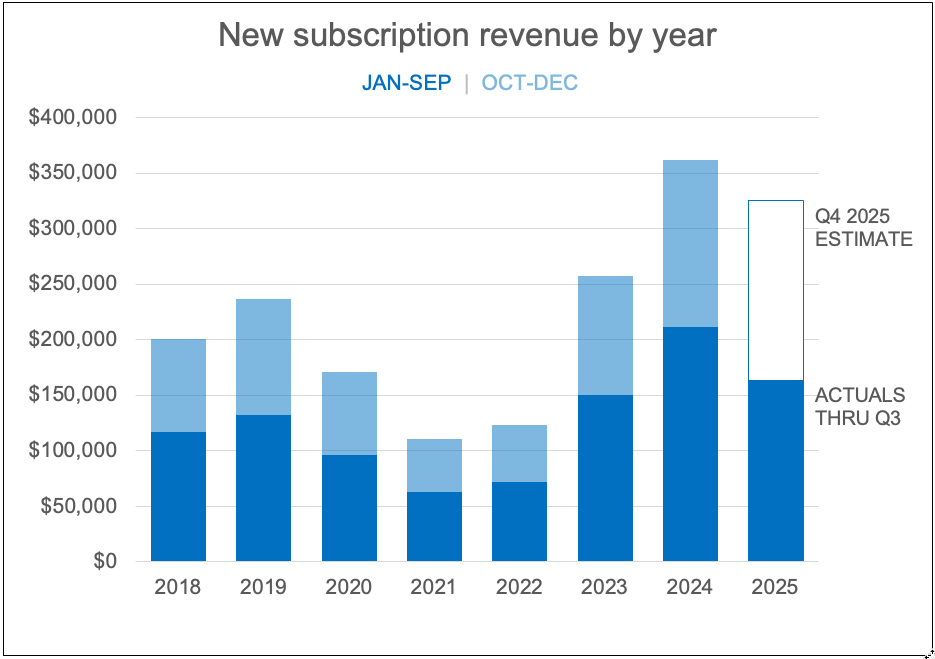
A final option is to show even more detail. For example, we might plot monthly subscription revenue for each year, excluding the outstanding months for 2025, to highlight the incompleteness of the current year. An added footnote also clarifies when the numbers were extracted, leaving no room for ambiguity.

This more granular view looks quite busy. It is worth considering how much data is required. Depending on the message we want to convey, we might consider keeping only the most recent years. Displaying just the relevant information reduces the cognitive effort needed to understand the trends.
When sharing data for an incomplete reporting period, be deliberate about context to avoid confusion. Take care to differentiate between complete and incomplete information with helpful labels and annotations, and adjust the marks to ensure they stand out clearly. Consider what your audience needs to know: do they need the latest snapshot, a full-year forecast, or a fair period-over-period comparison? Choose a strategy that provides the most applicable comparison and always makes the completeness of the data unmistakably clear.
To practice implementing these strategies, explore this related community exercise.
2025-11-11 04:12:03

This month marks the 10th anniversary of the publication of my first book, storytelling with data: a data visualization guide for business professionals.
When the book first came out, I had no idea what to expect. I was simply thrilled to see my name in print! I had been facilitating workshops for several years by then and had reached the limit of how many people I could personally teach. The book became my way to make those lessons—and everything I was learning about communicating with data—available to a wider audience. My goal was simple: to help others share their data more effectively.
It’s done that. And so much more! storytelling with data has been translated into dozens of languages (my favorite foreign cover—ironically—is the Italian edition featuring a man leaping out of a pie chart!) and is used to teach at universities around the world. Just last week, I visited Arizona State University to share lessons with employees, instructors, and students. I never could have imagined how many people I’d meet, or the places I’d travel, because of this book. It has connected me with people around the globe—and even introduced me to a number of the individuals who now make up the storytelling with data team. This book truly changed my life.

Earlier this year, when my publisher suggested creating a special anniversary edition, I jumped at the opportunity. I reread storytelling with data for the first time in years and was happy to find that its foundational lessons still hold true today (perhaps even more so in this age of AI). While the core content remains unchanged, I added a new foreword and three appendices capturing key insights from the past decade. The example graphs have been refreshed with current data. The design has been elevated: a crisp white linen hardcover stamped with magnesium ink, coordinating endpapers, and some fun surprises that I’m extremely excited to share with you.
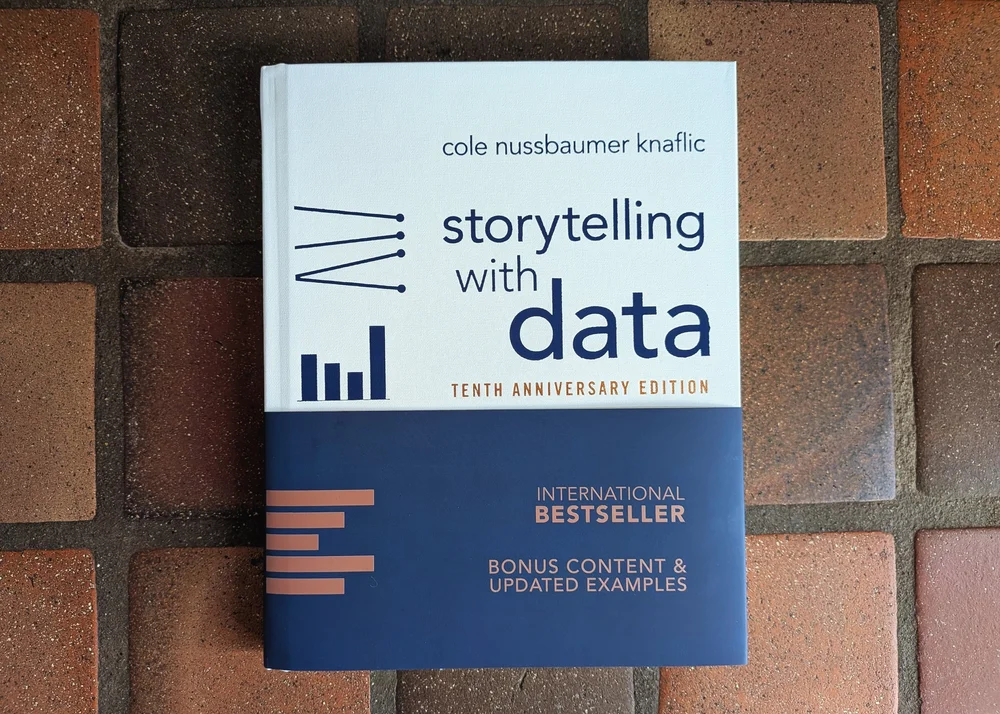


Perfecting these details took a little longer than expected, so the official publication date (originally planned for this week) has shifted to December 2nd. Books are already on their way to retailers and will be in circulation very soon. You can order your copy today.
To coincide with publication, I’ll host a live virtual celebration on December 2nd, reflecting on key lessons that have stood the test of time. I’ll revisit classic examples and share new ones, highlighting both simple steps for better graphs and deeper insights to strengthen your data storytelling. I hope you’ll join me for this free virtual session (and I welcome you to extend the invitation to others!).
As I’ve reflected on this milestone, I’ve found myself revisiting old photos. The one at the top of this post reminded me of another that made me smile—and filled me with awe at the passage of time. Ten years ago, my oldest son, Avery, played in the box that delivered my first copies of storytelling with data. This weekend, almost-13-year-old Avery helped me move boxes of the 10th anniversary edition.
Thank you for being part of this journey. I hope you enjoy the new edition of storytelling with data as much as I’ve loved bringing it to life.

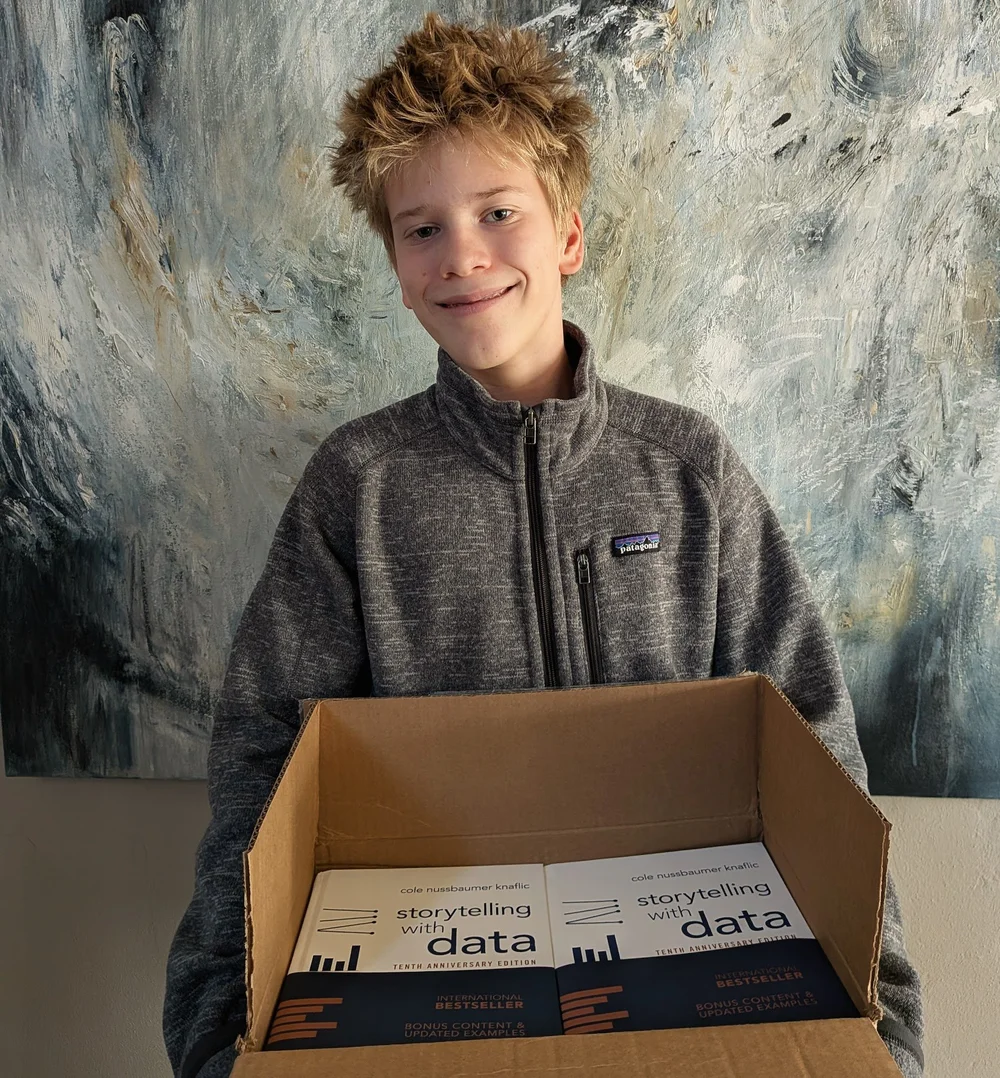

2025-10-28 08:19:41
Bringing clarity to your data storytelling doesn’t usually mean you need to learn and use more chart types. It does mean choosing visuals that are appropriate for your data and what you’re trying to communicate. Two of the most useful tools in our graphing toolkit—bar charts and line graphs—often do the heavy lifting. Knowing when to use which (and when to switch) can make all the difference.
This lesson came up recently as I revisited our new book, storytelling with data: before & after. I’ll share two scenarios where the choice between bars and lines matters. They are both from Chapter 2, which is titled “embrace basic graphs.”
Let’s start with the client-inspired example. Spend a moment reviewing the following. This slide (created by an external consulting company, Alpha Omega Group), was part of an annual business review for our client, a luxury cosmetic brand called Rapture. (Names and details have been modified to preserve confidentiality.)

Though the slide and graph appear reasonably professional at first glance, a closer look reveals opportunities for improvement. Let’s first recount some of the positives. The slide features a clear takeaway articulated at the top. Specific data points that relate to the takeaway title are encircled. The graph is mostly free of clutter. The data is plotted in a simple line graph—one of our preferred types.
But does a line graph make sense here?
When opting for a line graph, you want the lines themselves to mean something. In this instance, the lines reflect the relative difference between categories, which isn’t particularly useful. That’s not to say a line graph won’t work here, but this isn’t the one I’d recommend for categorical data. We’ll look at a variation soon. First, let’s see what this looks like in a graph made for this type of data: a bar chart.
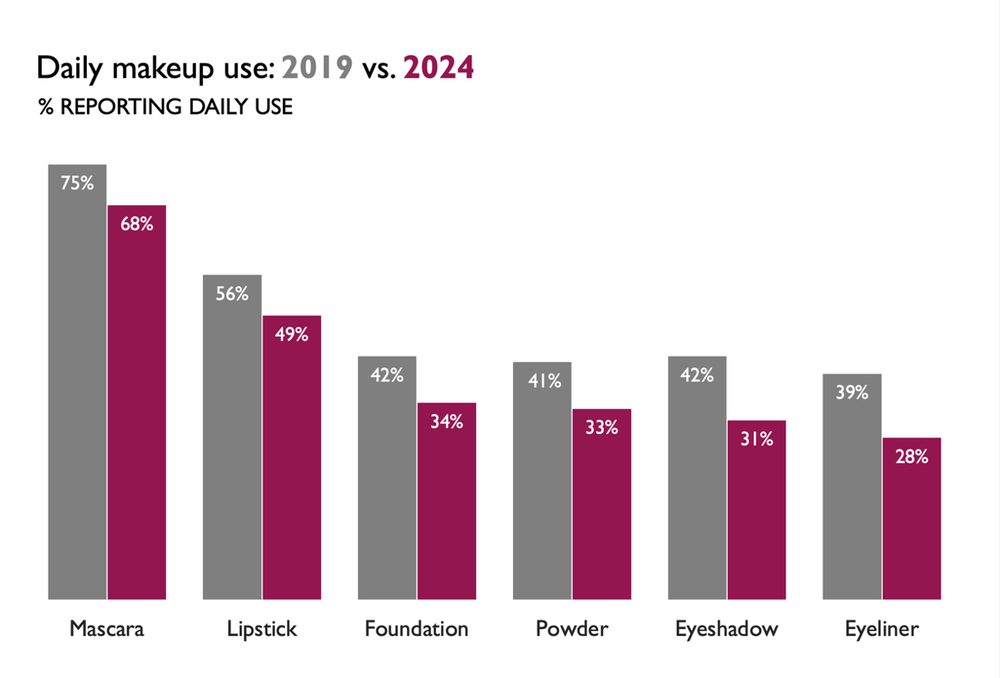
Bar charts are almost always a reasonable option. I’ve been known to joke that if I were stranded on a desert island with only one type of graph to use forevermore, it would be a bar chart. In our collaboration with clients, bar charts often become the hero when faced with unclear or overly complicated visuals. In this instance, I started with a standard vertical bar chart, also known as a column chart. We could also plot this data in a horizontal bar chart.
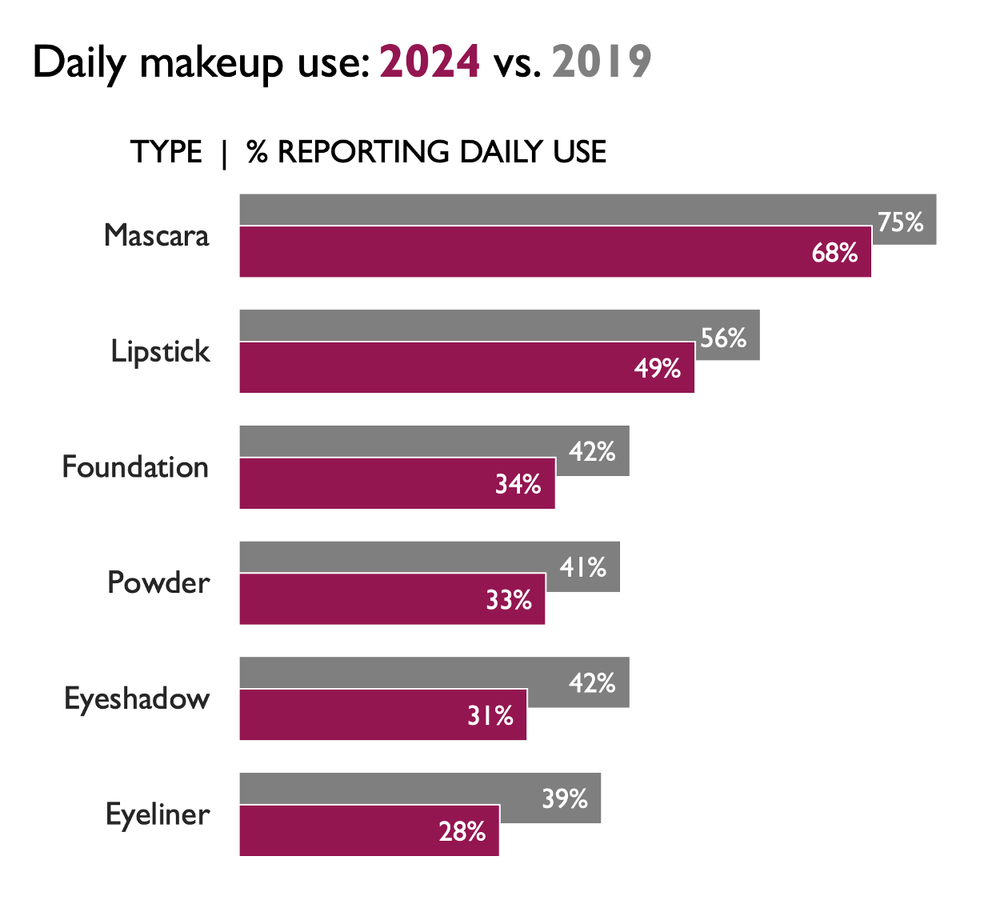
I played a little here, overlapping the bars so that the latest point in time is in the forefront, with enough of the historical data showing to still make the comparison. (If this bothers you, an unoverlapping version would also work.)
While I do love a good bar chart, bars aren’t our only option. I’m going to continue to iterate. Each version reveals something new about the data, highlighting how useful it can be to explore multiple perspectives before settling on the final view. Let’s look at the data in a slopegraph.
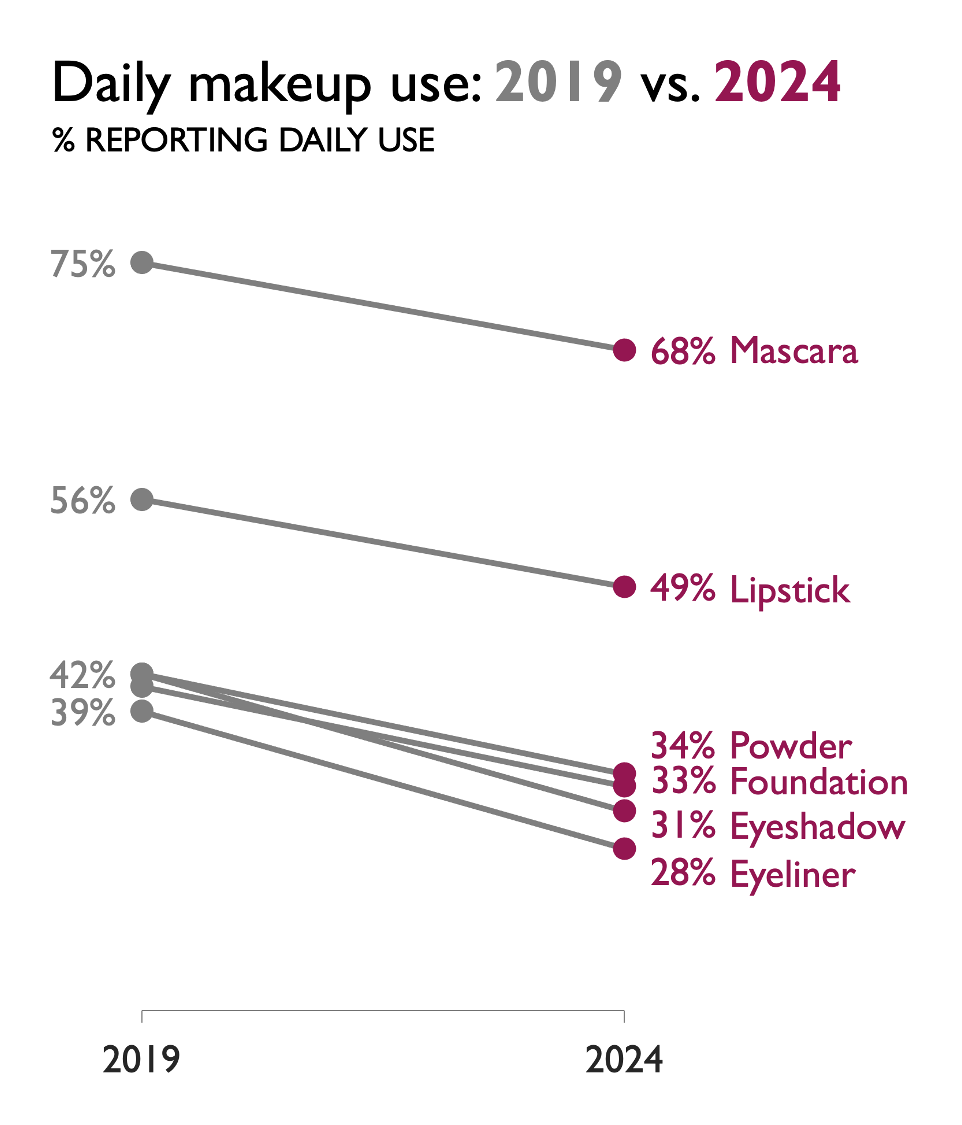
Whereas bar charts place emphasis on absolute values (the height or length of the bars), slopegraphs and dot plots draw attention to the difference or change (via the lines or distance between the points). With the slopegraph, I more quickly see the declines in daily use across all six products.
Let’s try looking at this data in a dot plot.

Something else stands out to me in the slopegraph and dot plot that didn’t in the bar chart views: how much more mascara and lipstick are used compared to the other products. Going back to the original takeaway, it’s true that eyeshadow and eyeliner decreased the most during COVID. But is that where we want our audience to focus?
As it turns out, no. Several slides later in the client’s original deck, it became clear that the key recommendation was to focus on restoring mascara and lipstick to pre-COVID daily use, with the expectation that the other products would follow.
Now knowing what I want my audience to see when they look at my graph, I can revisit the options I’ve considered and choose one that will facilitate this.

Any of the above options could work, with the right focus and words. I find myself drawn to the horizontal bar chart. You might choose a different option, and that’s fine. The following is my redesign, assuming that I’m constrained to a single slide.

If I were going to present this information live, I’d weave together a narrative by showing multiple iterations of the same graph. I could start by making the overall point that post-COVID makeup use is lower across all products. From there, I could highlight the largest decreases in eyeshadow and eyeliner use. Then, I could shift attention to mascara and lipstick as the consistently most-used products. Finally, I can conclude with the recommendation to prioritize strengthening marketing efforts on those products, with the expectation that others will follow. See the following slides.
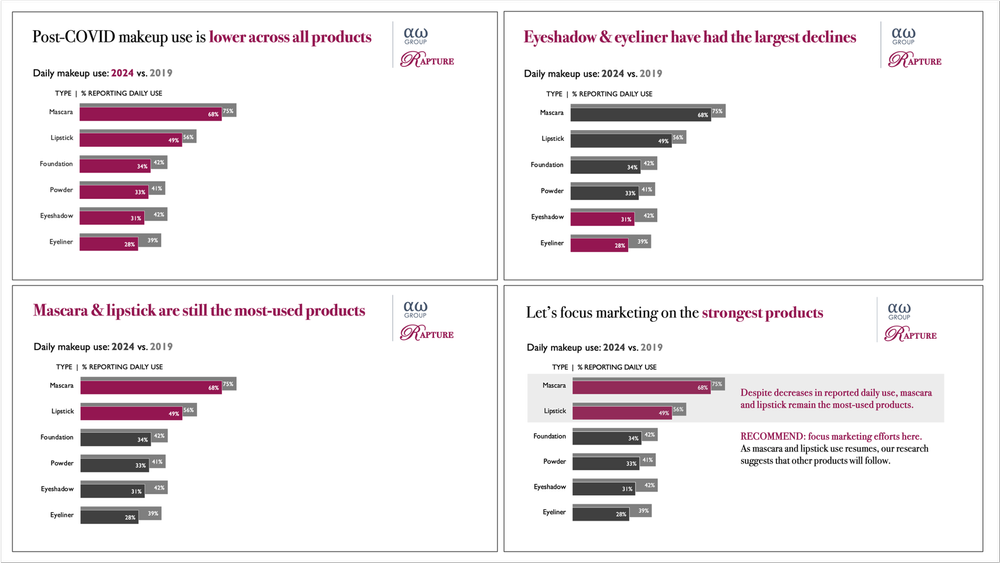
In the appendix of the same original client deck, there was a prime candidate for a line graph that wasn’t initially presented as one. See below.

Perhaps because it was an appendix slide, no supporting context was provided. Even in absence of that, I believe a line graph works better here. In the following iteration, in addition to transitioning to a line graph, I redesigned the visual to incorporate the client’s font and colors.

Recall the line graph at the beginning of this post, where the lines connecting categorical data didn’t make sense. Here, the lines effectively plot data over time. Each line segment conveys the relative change from one year to the next through its rise or fall.
For example, if you focus on the lower gray line in the graph above, you can see that it is relatively flat from 2020 to 2023. Then, there is a marked increase in slope between 2023 and 2024—and an even bigger increase from 2024 to 2025. Something clearly happened here that drove up minimum production (interestingly, the increase in minimum production seems to have lagged behind the increase in average production).
Now that you’re aware of this, you can go back to the bar chart and find the information. However, it would have been much harder to see without this new perspective. One benefit of using a line graph to plot data over time is that it mimics the way we intuitively follow a timeline, drawing our attention to fluctuations and trends.
As a slight twist, we could show the range from minimum to peak as a shaded area. You can see this below. I’ve also added some example text annotations. Given the lack of context, I used these to demonstrate where they might be placed and how to format them, rather than providing meaningful content.

I’m a long-time advocate of embracing basic graphs. Bars and lines have stood the test of time because they do their job exceptionally well. (The cousins we explored here, slopegraphs and dot plots, are variations of these.)
One thing that has evolved for me—and that you can see play out through the examples shared here—is understanding the nuance behind these simple forms. It’s not just what you show, but why and how you show it that sets effective data storytelling apart. The magic happens when you know which to use, when to switch, and why that choice helps your audience see what matters most.
If you enjoyed the before-to-after progression of this example, you’ll love our new book, storytelling with data: before & after. It features 20 inspiring makeovers, sharing a multitude of practical lessons along the way.

2025-10-10 16:00:03
Reducing redundant elements in our visuals and moving beyond our tools' default settings almost always makes insights faster to retrieve. It’s such a critical part of clear communication that we dedicate an entire section of our workshops to it.
However, we close that very same lesson with an important truth: decluttering alone isn’t enough. If a sub-optimal chart type is used or the critical message remains hidden, the audience may still walk away confused.
Today, let’s take a look at how much better a graph can look when it’s been decluttered—and then, how much stronger it can be when we prioritize our main message.

This visual shows the status of work orders across four critical asset types within an engineering company.
Along the horizontal axis, we see each of the four asset types: boiler feedwater pumps, high voltage substation switchgear, distributed control system, and pipe rack.
The primary (left) vertical axis of this dual-axis chart plots the absolute number of orders within an asset type, broken down by closed (blue bars) and open (orange).
The secondary vertical axis tracks the percentage of orders closed per asset type. The goal of this view is to help leadership see which asset areas are meeting order closure expectations and which require additional focus.
Everything our audience might want to know is present. But that’s part of the problem: there’s too much happening at once, and the dual axis makes it difficult to know what to focus on. Is the takeaway supposed to be the number of orders? Or the closure rate? Or both?
As with most graphs that use primarily the default settings of a graphing tool, this one can be improved with some common decluttering techniques. Let’s do this now by taking the following steps (with some useful links to previous articles on these topics included):
Removing the chart border;
Adjusting the graph proportions;
Decreasing the white space between the bars;
Removing the data labels;
Formatting the axes: providing titles, using lighter formatting and adding axis lines and tick marks;
Moving the legend from the bottom of the view to the top, acting as a subtitle;
Rewriting and aligning the chart title
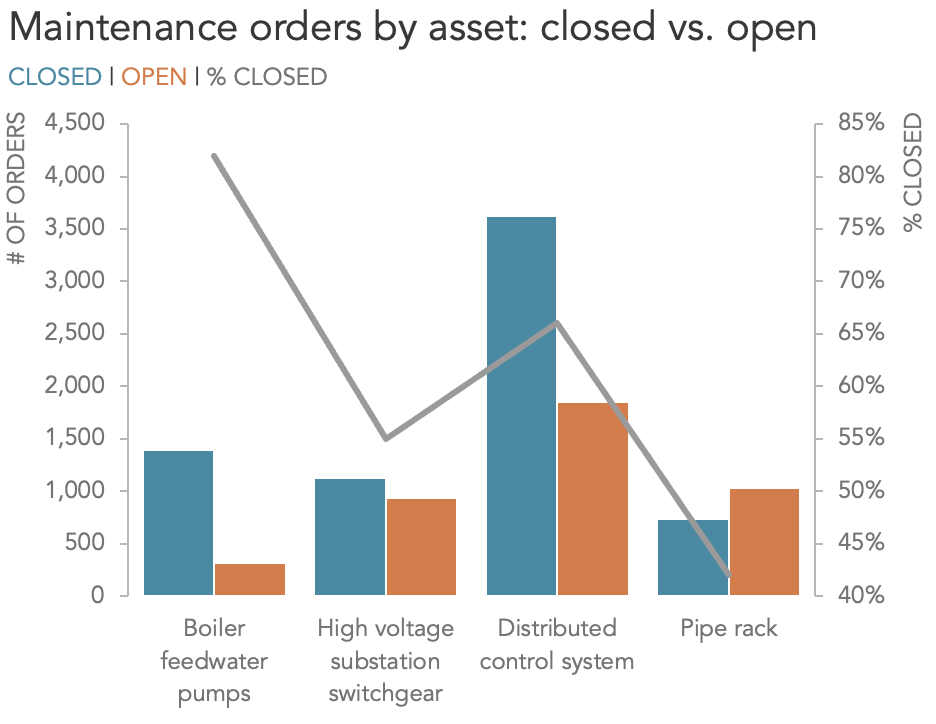
The combination of these changes helps to lighten the visual load and make it easier to focus on the data. Applying a similar combination of the steps referenced above works well in most situations and will almost always lead to an improvement. And if you’re short on time, even a quick round of decluttering can make a meaningful difference.
Even with these changes, it’s still challenging to make immediate observations about the information. At this point, we should think critically about the message we want to deliver and whether our graph types and design choices support that communication effectively.
We’ve done our best to tidy the view, but any graph that incorporates dual axes requires an audience to expend a lot of mental energy, keeping track of the multiple metrics in the plot.
Instead, consider exploring different ways to present this information. One way we can transition away from the combined axes is to pull the graphs apart vertically, leveraging the same horizontal axis across both views, but with each getting its own independent vertical y-axis.
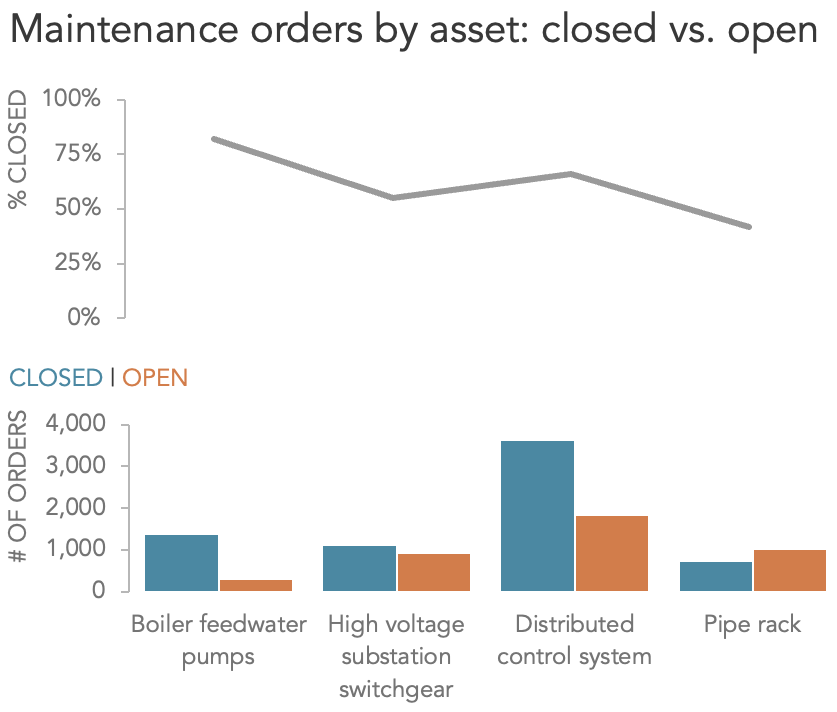
Having made this change, I’ve noticed something off. Lines work well for continuous data over time, but here we’re dealing with categorical data—the asset types. In this instance, joining the closure rates for each asset creates a relationship that doesn’t exist. To correct this, I’ll convert the line to individual bars, which will better represent this distinct, discrete data.
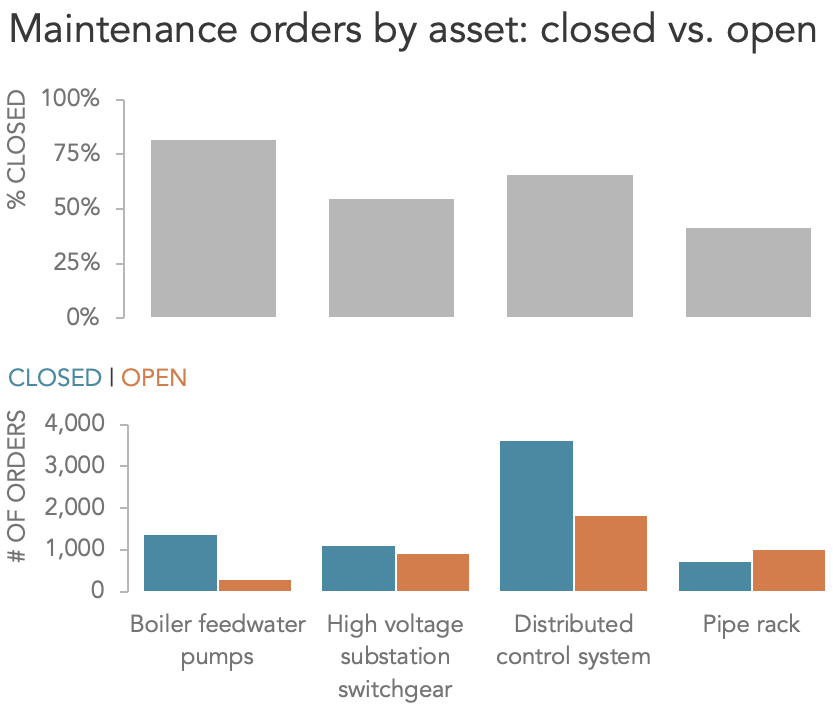
Technically, that’s better, but something still feels off. Maybe we’re still trying to show too much all at once. Do we need all this information? In those cases where we feel obliged to show all of the data we collected or analyzed, we sometimes wind up talking ourselves into creating needlessly busy visuals. Often, a subset or aggregation of that data would lead to a much clearer final product.
Continuing to iterate, I’m going to drop the closure rate information. Then, I’ll switch from positioning the closed and open bars next to each other to stacking them on top of one another.
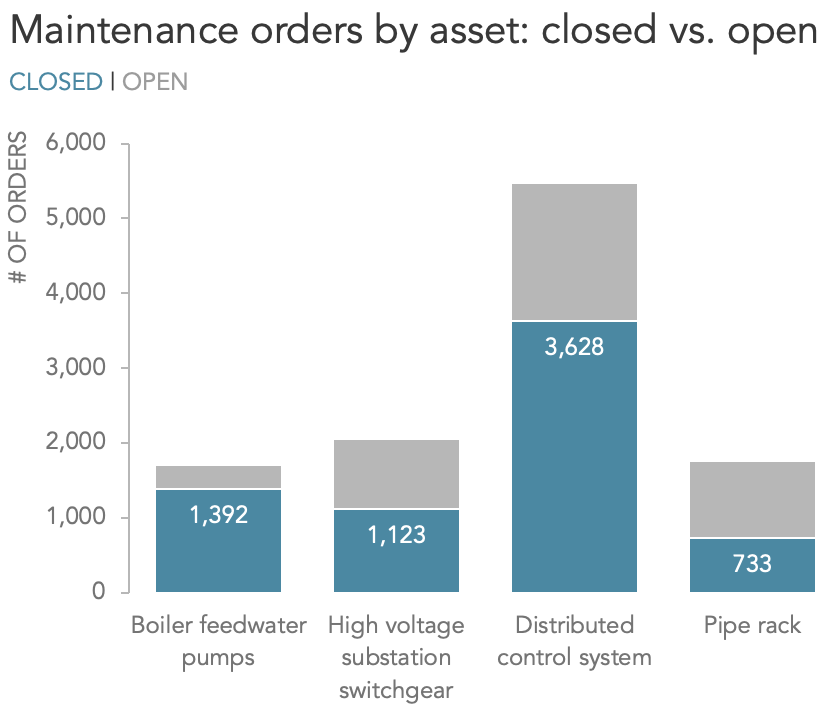
The stacked bar chart allows us to see total orders per asset while allowing for straightforward comparison of the closed orders for each asset type. Now that the order closed rate has been removed, we can be clear about the intention of this visual, and displaying only the relevant data reduces the cognitive effort required to understand the information.
In conversation with colleagues, we determined that the one thing our audience cares about the most is the closure rate within each individual asset type. Is this visual helping articulate the primary takeaway of that metric, which is that most maintenance orders for pumps have been closed (82%), while fewer than half of those for pipe racks have (42%)? We can see this at an absolute level, yes, but with teams monitoring these assets of markedly different sizes, showing the number of orders is likely not the right approach.
With the original visual and closure rate line in mind, I’m inclined to explore a different view.
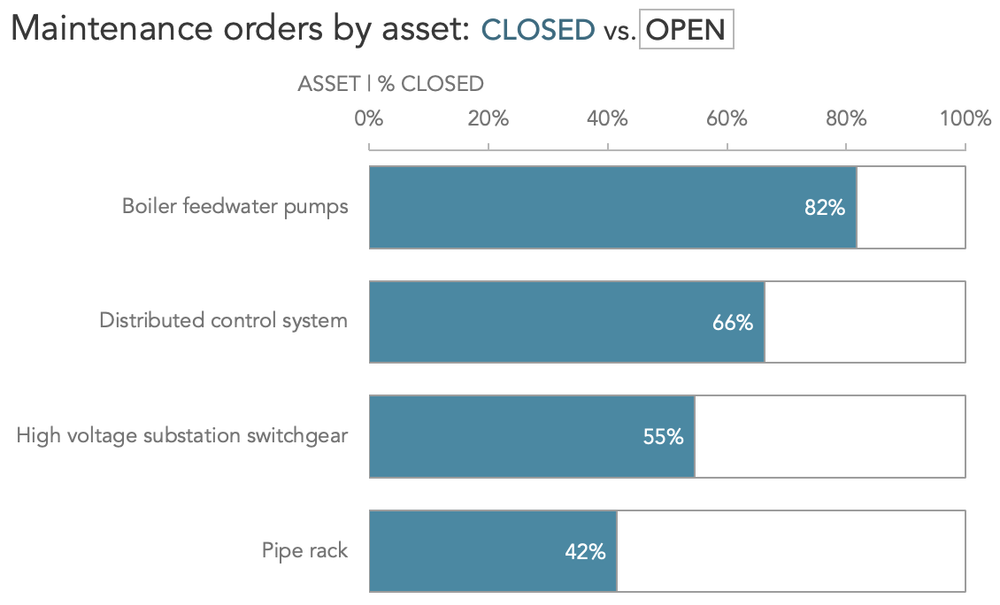
Switching to a 100% stacked bar chart now clearly shows the proportion of orders that have closed. At this stage, I also took the opportunity to switch to a horizontal orientation to ensure the category labels—which in the previous iterations were distracting and fell across a combination of one, two or three lines—sit neatly on a single line. Finally, I chose to order the data series in decreasing order of performance.
The final view allows for immediate and accurate comparisons to be made. Now that I’ve landed on an appropriate chart type, the final step is to add elements that help frame and explain the data: a goal line of 80%, an observational takeaway to prime our audience with the key message behind the visual, and an open question to prompt discussion.
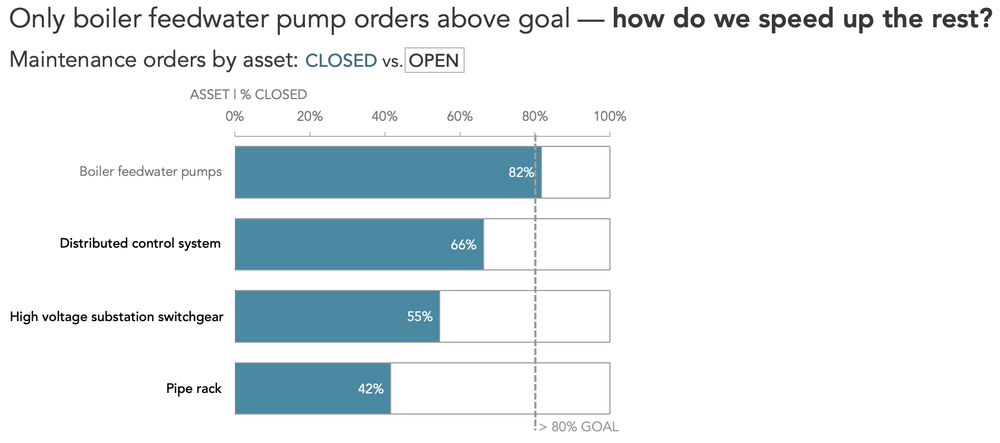
Unlike the original, the story is obvious: only the boiler feedwater pumps order closures are at an acceptable level, while the other asset types fall below appetite. Conversation can now turn to remedial efforts to expedite order closures in these areas.
Decluttering our visuals is always a great first step, and one in which a similar approach can safely be applied to most visuals. For the strongest communication, however, decluttering alone isn’t enough. Removing redundant elements might help us see the data, but if the chart type itself isn’t aligned with the story; the ability to retrieve the insights quickly is compromised. Real success comes not just from sharpening up the original chart, but from rethinking how best to present the data, ensuring the main message you are looking to share is clearly accessible.
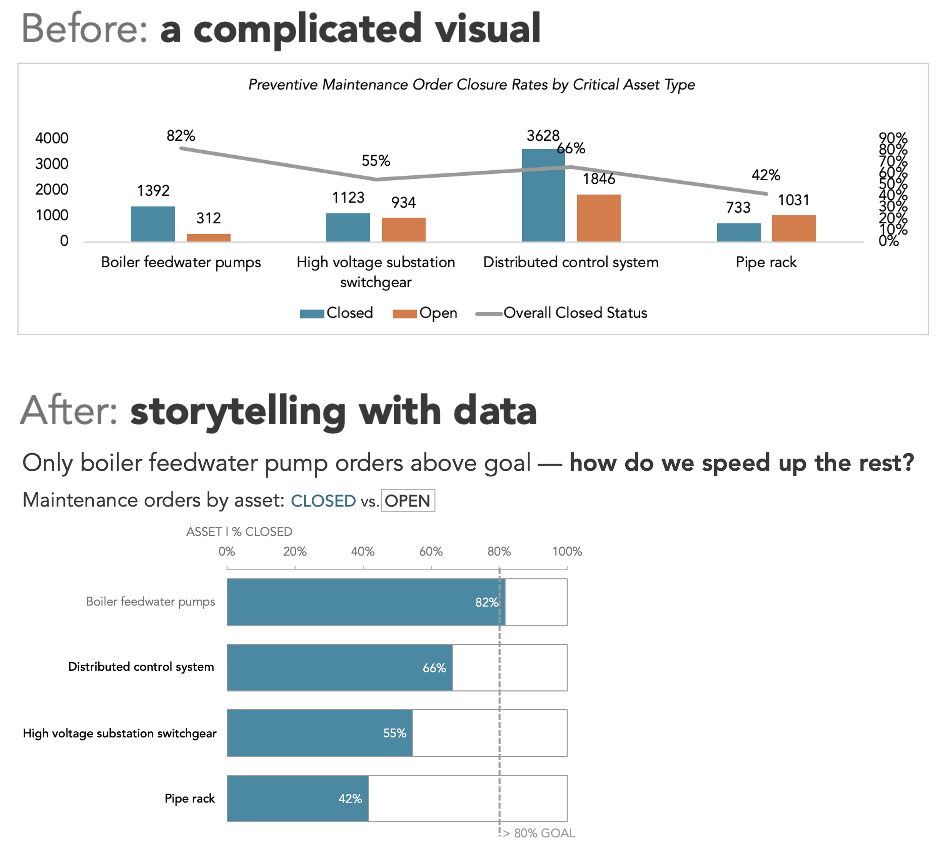
If you enjoy seeing how we help real teams improve their business communications via example, order our latest book: storytelling with data: before & after. Drawing on more than a decade of helping organizations and professionals transform their communications, the book features twenty powerful makeovers that turn ineffective charts into engaging visuals that captivate, inform, and drive smarter decisions.
